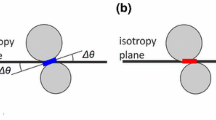Abstract
A general formulation of the Helmholtz free energy used in thermodynamics of damage process of rocks is derived within a multi-scale framework. Such a physically-based thermodynamic state potential has a hybrid, discrete/continuum, nature in the sense that it adopts a continuum description but subsumes the statistical ensemble average of the action of the entirety of microscopic degrees of freedom. The choice of the relevant damage variables results therefore directly from the breaking of contact cohesive bonds, and it naturally obeys the Clausius-Duhem inequality. Furthermore, motivated by the fact that the free energy is formulated by the integral of potentials independently defined on different orientations over the upper hemisphere, the damage evolution equation is formulated on a generic orientation. Consequently, the mechanical behavior of a rock material generally becomes anisotropic characteristics in the inelastic regime even if the material is initially isotropic, thus introducing dissipation-induced anisotropy in a very natural and simple way. Finally, the development of the lattice solid model can be cast into the framework of the orientation based continuum constitutive model.
Similar content being viewed by others
Author information
Authors and Affiliations
Corresponding author
Rights and permissions
About this article
Cite this article
Liu, X., Yin, X. & Liang, N. Orientation-based Continuum Damage Models for Rocks. Pure appl. geophys. 163, 2529–2543 (2006). https://doi.org/10.1007/s00024-006-0136-9
Received:
Revised:
Accepted:
Issue Date:
DOI: https://doi.org/10.1007/s00024-006-0136-9




